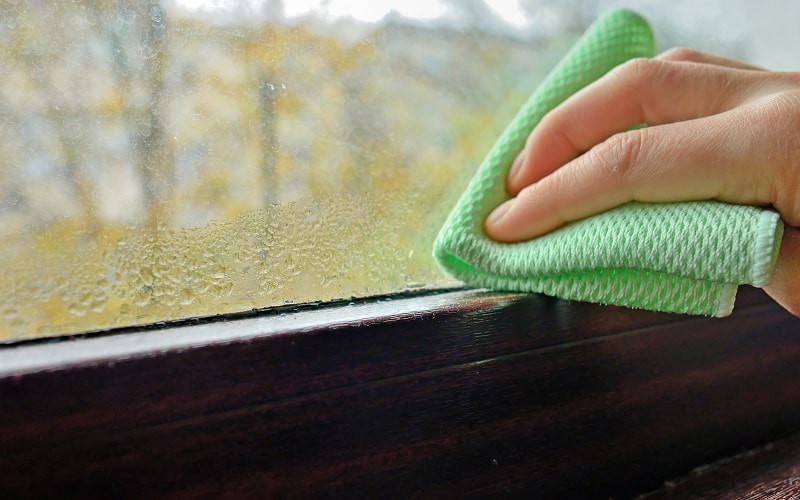Condensation can form on windows, walls, tiles and many other surfaces in a home. It can also occur during the day and the night.
So, how do you stop this pest of a guest from getting into your home and creating havoc? Read on to learn more about how to stop condensation in a property.
What Is Condensation and What Causes It?
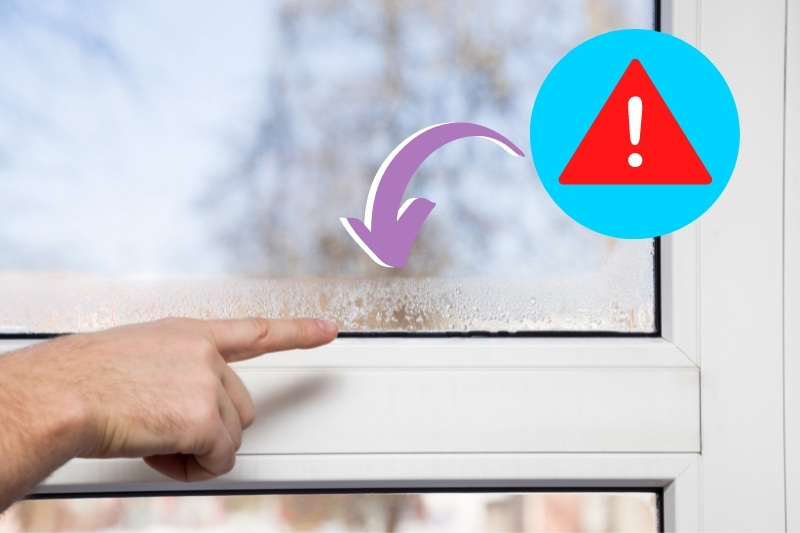
Before trying to solve your condensation-related issue, it’s a good idea to find out what condensation is and why it’s in your home.
Condensation occurs when warm moisture in the air makes contact with a cold surface. As a result, the air turns back into a liquid state, and water droplets form on the cool surface. And you also get condensation in places that have too much humidity!
These destructive water droplets are often fairly obvious, but sometimes they go entirely unnoticed in a property. But whatever the case may be, it’s imperative that you find the source of the problem and prevent it from causing damage to your home.
Not noticing and not solving a condensation-related issue in time can lead to a multitude of problems, including peeling paint and wallpaper, creating a mould-friendly environment, and structural damage to a property.
Condensation typically occurs in the winter and appears in places with inadequate ventilation/airflow and where there is a significant temperature difference in a room.
For example, when you boil water on a hob in the kitchen, and you don’t use an extractor fan or open a window, the trapped humid air will make contact with the colder surfaces in your kitchen, and you’ll see water droplets forming and running down the window panes, walls and tiles.
Now you’ve got a better idea about what condensation is and why it forms, you can find out how to stop the issue from occurring in the first place!
General Tips for Stopping Condensation
Here are the main ways you can stop condensation from plaguing your home.
The points below can be applied to almost every room in the house, and if carried out effectively, they should prevent condensation or at least limit it significantly.
- Ensure there’s good ventilation in your home. This will not only prevent condensation but also stop the air in the house from being polluted.
Polluted air can make you feel ill (sore throat, headaches, chest pain and so on), so it’s a good idea to ensure there’s good airflow in your property anyway. - Use extractor fans wherever possible because they’ll help to shift the unwanted moisture and steam from your adobe.
- Wipe condensation off surfaces so the droplets don’t have time to pool together and form mini puddles that run down your surfaces. Window sills and walls, especially those made from wood, will rot when exposed to excessive amounts of water.
- Open windows so fresh air can move in and out of spaces and also so hot air can escape.
- A dehumidifier can be used to manage condensation in a home. These devices draw moisture from the air and condense it internally.
These machines are excellent at managing moisture in a home and can be placed in some of the most moisture-ridden rooms too.
There are various makes and models on the market today, and their prices vary, see our dehumidifier guide for more information. - Don’t dry wet laundry inside. And if you do dry laundry indoors, put measures in place to manage the excess moisture that comes off the clothes or use a tumble dryer.
- Utilise moisture traps throughout your home. These traps are usually small enough to slot into cupboards, so they can control the moisture in these areas for you! They also don’t cost that much to buy!
- Ensure that your home is adequately insulated and that you have double-glazed windows throughout the property. This will help keep your home warm, and in turn, the surfaces inside your abode won’t be so cold that condensation forms on them.
- You could try leaving the heating on (but run it at a low temperature) to keep your home toasty throughout – this may not be the most cost-effective option.
- Fix any obvious issues with your fittings – broken window seals or panes, for example. These damaged items will allow heat to escape and for the cold to enter your abode, so sort them out!
These are the basic things you can do to stop condensation in a property. Let’s take a look at how you can put an end to condensation in specific rooms and surfaces in your home!

How to Stop Condensation in Bathrooms, Kitchens and Utility Rooms
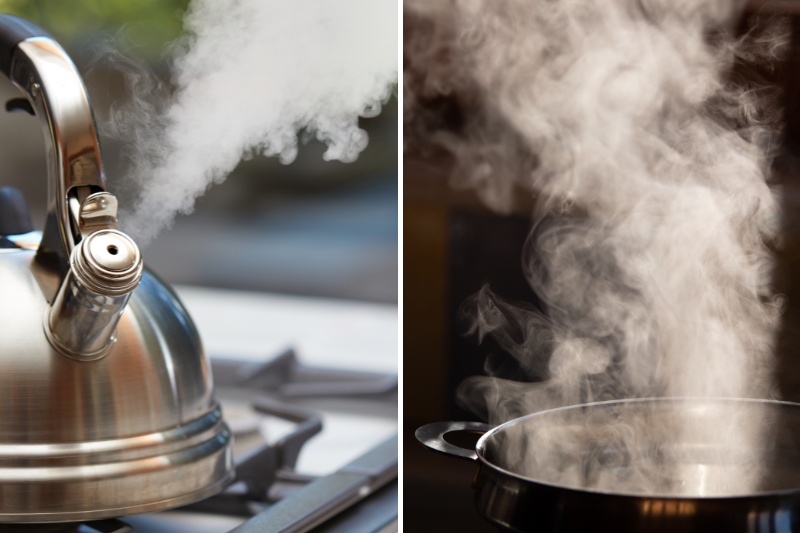
Kitchens, bathrooms and utility rooms are condensation hotspots because excess moisture and humidity are released into these areas regularly.
You can solve this issue by:
- Making sure you switch extractor fans on when showering, cooking or using appliances in a utility room.
- Leave extractor fans on for a few minutes after you’ve finished cooking or bathing, so they can remove even more steam from the room. It’s also worth keeping the door to the room shut so that most of the moisture gets removed in one go.
- Make sure that you open the windows to leave steam out when cooking and showering. You don’t have to open the window very wide, but make sure it’s open enough so that the hot air can escape!
- Use a dehumidifier, if necessary, or certainly use moisture traps in kitchen cupboards to help manage the situation.
- Shut the bathroom or kitchen door so warm air doesn’t travel throughout the house and cause more condensation-related issues.
- Put wet towels on a towel rail to dry after using them. Don’t leave moisture-riddled towels in a pile on the floor.
- Dry your water-logged bathmat.
- Ensure your tumble dryer has sufficient space. And if you’re using a vented dryer, make sure that there is a vent in place, or you put the hose outside when the appliance is on.
Tip: Check the humidity level in your home with a hygrometer – it’ll tell you when you’ve reduced the moisture levels in your home to a safe level.
How to Stop Condensation in Bedrooms, Dining Rooms and Living Rooms
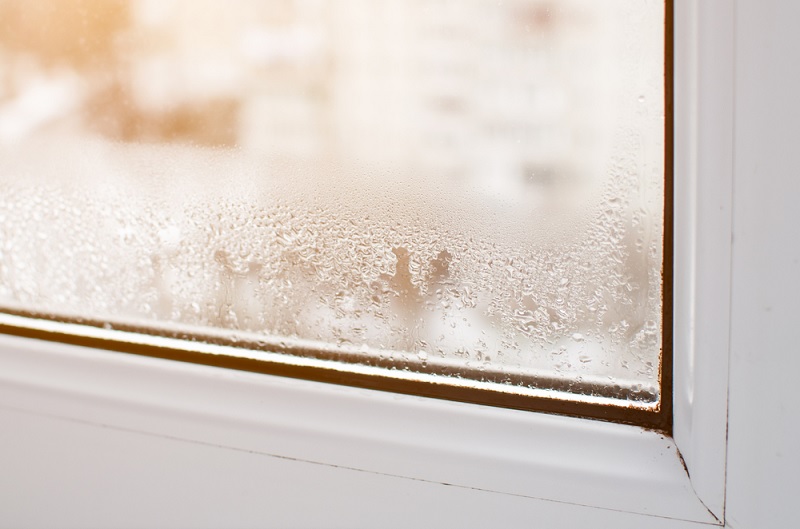
Your bedroom and various living areas are where you spend your time relaxing, but they may not be the most moisture-filled and condensation-riddled areas in your home.
Nonetheless, there’ll still be warm air and cold surfaces in these spaces, and condensation could make an appearance, so treat them as follows.
You can solve this issue by:
- Open up your wardrobe doors to allow fresh air to circulate inside the space. This is particularly useful if you’ve got built-in wardrobes that back onto an external, cold wall. This will also refresh your clothing for you. Clothes that never see the light of day and are packed into a cupboard or wardrobe can start to smell after a while.
- Add vents to your wardrobe so fresh air can get inside.
- Don’t pack your bedroom, cupboard, units, and wardrobes out with loads of stuff. Try to declutter as much as possible so that air can travel freely. If you have too many items, consider donating them or repurposing them!
- Open the window slightly during the night so you allow your warm breath to escape the room.
- Leave your bedroom and living room curtains open.
- Don’t shut the bedroom door because you want air to flow around the room.
- If you’re going to put curtains up, don’t put them flush against the glass panes. Leave a sufficient gap so air can circulate.
- Keep rooms consistently warm throughout the night, so there aren’t cold surfaces in your home where warm air can land on. This doesn’t mean boiling. Choose a toasty temperature that’s comfortable for you to sleep and relax in. If you do this, you won’t have many cold surfaces in your home, so there’s less chance of condensation forming.
- Don’t put your sofas, wall units, TV stands, table, and general furniture against the walls. Leave a gap so air can flow around the items.
How to Stop Condensation on Walls and Ceilings

Ceilings and walls are prone to being coated in condensation, and the main issue with this is that it can give rise to mould-related issues and even dampness. You must stop condensation from getting to walls and ceilings.
You can solve this issue by:
- Switch an extractor fan on to remove steam from the room when cooking or showering, so condensation doesn’t have time to form on the walls and ceiling.
- Open windows to leave steam out when cooking or showering so the warm air doesn’t settle on cooler surfaces.
- Pop lids on boiling pans when cooking to trap the steam.
- Use a dehumidifier to take out the extra moisture in the room.
- Don’t dry clothes indoors because this can encourage condensation to form on cold walls. And if you do, use a dehumidifier to gather excess moisture from the air.
- If you use a humidifier, use it on its lowest setting.
- Ensure there’s airflow in your home. A simple way of doing this is to remove excess clutter from your home so fresh air has space to move around. You can also open doors and windows.
- Don’t leave objects/items flat up against a wall. Move the items away from the wall so air can travel behind the things.
- Coat walls in anti-condensation paint like this paint from Ronseal to help manage the problem and to stop mould from appearing on walls and ceilings.
How to Stop Condensation on Windows (Day and Night)
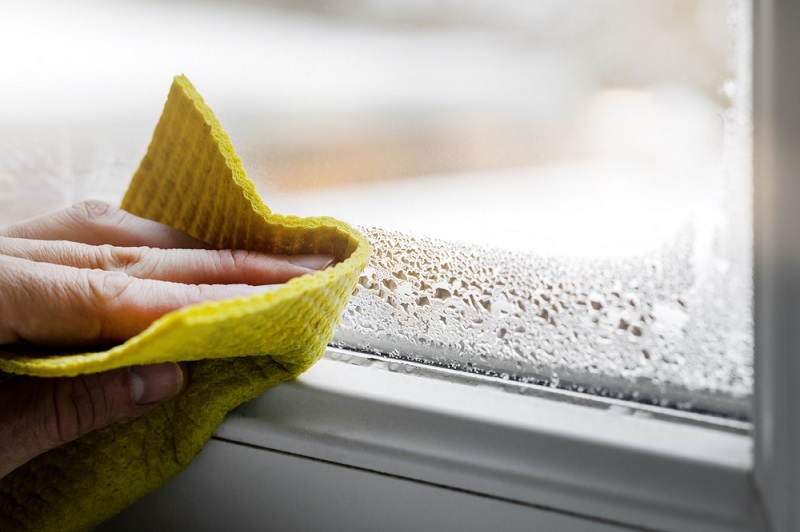
Condensation typically forms on the inside of windows because there’s a temperature difference between the inside of the house and the outside world.
Naturally, the warm air inside the room will make contact with the cold window pane (which has been subjected to whatever the weather is outdoors), and droplets will form on the cool surface.
You can solve this issue by:
- Make sure there aren’t significant changes in temperature around your home. For example, don’t have a freezing kitchen and a boiling living room – keep both rooms as equal as possible. You can usually achieve this by keeping your heating on a low heat throughout the property. Of course, you must factor in the costs involved with doing this.
- Ensure your home has sufficient draught proofing, cavity wall insulation, and double-glazing. This will ensure that you don’t lose too much heat from your abode and can help to stop condensation.
- Dry the water droplets off your windows as soon as they appear so the water doesn’t have time to run down and ruin/rot the walls/wooden features around the window. You can do this by wiping the windows with a towel or squeegee.
- Move plants away from windows.
- Open the curtains so warmer air doesn’t get trapped on cold panes and window frames.
- Use thinner curtains that aren’t so big and bulky around windows that are prone to gathering condensation!
- Leave the extractor fan on for 20 minutes when you have left the room so that it can remove excess moisture. This should help to clean the window panes.
- If your windows are old, replace them with modern ones with better insulation.
- Don’t dry wet clothes near windows. And if you do, make sure you open the window, or at least use a dehumidifier to gather the excess moisture from the air.
- Make sure there’s sufficient ventilation near the windows. For example, you might need to add air bricks into the walls to ensure better ventilation.
- Check and fix any damaged or broken seals on your windows. The degraded seal could be leaving water in. Re-sealing or getting new windows is usually the way forward if you have this issue.
- Install weatherstripping onto your windows. Weatherstripping helps to keep warm air inside your home and can stop cold air from entering your property. It works in reverse in the summer, so the inside of your home stays cool when the sun is beaming down outside!
Condensation forms at night for the reasons mentioned above, but also because people breathe inside their bedrooms for several hours at a time.
Naturally, as we breathe, we realise warm air into the room, which lands on a cold surface(s), and droplets form.
You can remedy this issue by utilising the points mentioned above.
Condensation can also form on the outer side of windows. But this generally isn’t a big problem because it evaporates away by itself in most cases.
Sometimes you can coat windows in hydrophobic chemicals to help the water slip right off the surface (like how water moves off a duck’s back), but this isn’t essential.
In addition to the above, if you’ve got condensation in between the panes, you should clean your windows to remove grime and a hazy look from them.
If this doesn’t work, you could call a professional over to look at the glass, and they may be able to replace the panes for you.
Failing this, you might have to replace the entire window, but a fitter should advise you further.

Bethan has a passion for exploring, reading, cooking and gardening! When she’s not creating culinary delights for her family, she’s concocting potions to keep her house clean!
